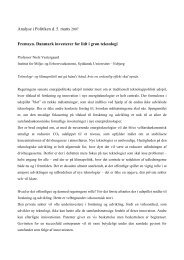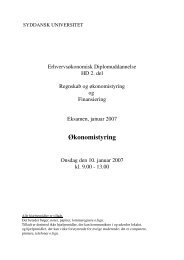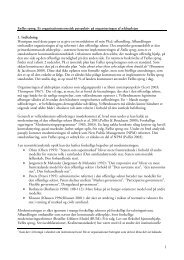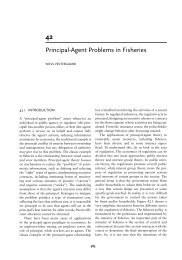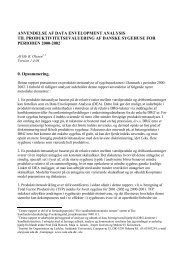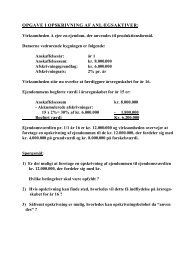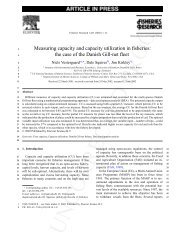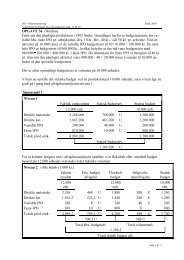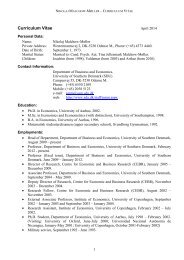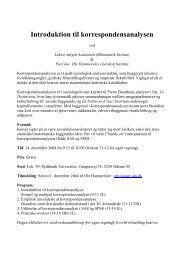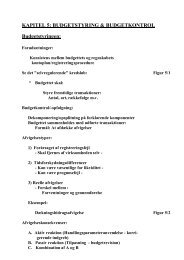analyses <strong>of</strong> party <strong>in</strong>stitutionalization. As he po<strong>in</strong>ts out, until now rather low attention has been givento the <strong>in</strong>ternal party dynamics, as these subjects are relatively difficult to analyse due to the limitedaccess to data.The party <strong>in</strong>stitutionalisation is closely connected with those mechanisms that distribute politicalpower between each section <strong>of</strong> the party, e.g. the parliamentary group <strong>and</strong> the party apparatus.Institutionalisation can take place <strong>in</strong>ternally by <strong>in</strong>troduc<strong>in</strong>g more regular decision procedures, orexternally by stronger l<strong>in</strong>kages to the society. In other words, <strong>in</strong>stitutionalization can take placewithout closer l<strong>in</strong>ks to socual <strong>in</strong>terests. Nevertheless, <strong>in</strong>stututional structures playes a still strongerrole when mov<strong>in</strong>g to more <strong>in</strong>terest based “ord<strong>in</strong>ary politics”. Does <strong>in</strong>stitutionalization become asuccess, more strict rules will be established <strong>and</strong> <strong>in</strong>ternalized for distribution <strong>of</strong> political power, atthe same time a rout<strong>in</strong>isation <strong>and</strong> legalisation <strong>of</strong> political enterprise can be observed.Institutionalisation tend to foster detailled <strong>and</strong> <strong>in</strong>ternalised rules <strong>and</strong> norms as regards cooperationon leadership level, mechanisms <strong>of</strong> conflict resolution <strong>and</strong> control. Political demobilisation <strong>and</strong>lower political participation will mostly be the result <strong>of</strong>, not the reason for higher<strong>in</strong>stitutionalisation.Legitimation is an important factor here, as legitimacy br<strong>in</strong>gs to <strong>in</strong>stitutions more freedom <strong>of</strong> action.Institutionalisation <strong>in</strong>evitably was most difficult to obta<strong>in</strong> <strong>in</strong> the first stage <strong>of</strong> postcommunismcharacterised by high voter volatility, functional <strong>and</strong> government overload, antipolitical attitudes <strong>in</strong>population <strong>and</strong> overparliamentarisation. In other words, <strong>in</strong>stitutionalisation took place underunsecurity <strong>and</strong> widespread transition anomie. An <strong>in</strong>stitutional vakuum could be observed, <strong>and</strong> thepolitical parties were not able to fill out that vacuum.L<strong>in</strong>kages to social cleavages <strong>and</strong> the prevail<strong>in</strong>g policy preferences <strong>in</strong> society are not <strong>in</strong> themselvessufficient to promote consolidation <strong>of</strong> democracy. <strong>Parties</strong> also have to be sufficiently strongorganisatorically to br<strong>in</strong>g the political messages to the electorate. Insufficient organisationalcapacity <strong>and</strong> bad party f<strong>in</strong>ances have been characteristic result<strong>in</strong>g <strong>in</strong> <strong>in</strong>ternal splits <strong>and</strong> weak policy<strong>and</strong>programme formulation. Formally the <strong>in</strong>stitutions were <strong>in</strong> place, but the attitudes forstrengthen<strong>in</strong>g <strong>in</strong>stitutions <strong>and</strong> make them functional, did not exist. Under those circumstances thepolitical agenda to a great extent was decided by other <strong>in</strong>stitutions, such as the presidency, foreign<strong>in</strong>stitutions <strong>and</strong> doners, crim<strong>in</strong>al structures <strong>and</strong> other <strong>in</strong>stitutions outside democratic control(“shadow <strong>in</strong>stitutionalization”). The democratically elected <strong>in</strong>stitutions simply do not fill out thevacuum. Shadow <strong>in</strong>stitutionalisation was most strik<strong>in</strong>g <strong>in</strong> the CIS countries <strong>and</strong> on Balkan, but notlimited to those countries. The worst case scenario is a long-term weaken<strong>in</strong>g <strong>and</strong> marg<strong>in</strong>alisation <strong>of</strong>the political parties. Accord<strong>in</strong>g to most op<strong>in</strong>ion polls the political parties <strong>and</strong> the parliament are lowestimated. Moreover, low <strong>in</strong>stitutionalization had as a result that elections could not be won because<strong>of</strong> close l<strong>in</strong>ks to the most important sections <strong>of</strong> society. For that reason better access to <strong>and</strong>unfortunately also more party control over the media became an obvious strategy for parties <strong>in</strong>power.Som esome extent all the CEEC’swere signified by <strong>in</strong>stitutional hybridization as some importantchanges <strong>and</strong> “open<strong>in</strong>gs” <strong>of</strong> the fomer authoriatarian systems took place, however, at the same timemany from the old elites were still <strong>in</strong> power, <strong>and</strong> post-communist <strong>in</strong>stitutions did not changefundamentally. In Pol<strong>and</strong> well organised <strong>in</strong>stitutions such as the church <strong>and</strong> some trade unions wereable to penetrate the political process <strong>and</strong> the parties due to strong organisation <strong>and</strong> close l<strong>in</strong>ks thecerta<strong>in</strong> parties.38
In Hungary the national bank, the constitutional court <strong>and</strong> the ombudsman <strong>in</strong>stitution placedrestrictions on the law mak<strong>in</strong>g process (“fragmentated democracy”). In fact we were deal<strong>in</strong>g with atoo early <strong>and</strong> too sifistcated <strong>in</strong>stitutionalisation. In Russia <strong>and</strong> Ukra<strong>in</strong>e strong f<strong>in</strong>ancial oligarchs,network<strong>in</strong>g, clientura’s <strong>and</strong> other structures outside democratic control arrogated to themselves amenac<strong>in</strong>gly strong position, thus weaken<strong>in</strong>g the freedom <strong>of</strong> action <strong>of</strong> the political parties <strong>and</strong> thel<strong>in</strong>ks <strong>of</strong> parties to civil societies. To some extent those non democratic structures orig<strong>in</strong>ated <strong>in</strong> theold state socialist system.To obta<strong>in</strong> a mean<strong>in</strong>g for the populations <strong>in</strong>stitutions have to be strong enough to <strong>in</strong>ternalise thenorms necessary for the survival <strong>and</strong> futher consolidation 29 . For that to happen the <strong>in</strong>stitutions shallbe capable to adapt themselves to the political environment, shape the optimal congitive frames <strong>of</strong>references <strong>and</strong> make complex realities more simple for the citis<strong>in</strong>s. Only thereby the sufficientloyalty <strong>and</strong> legitimacy can be obta<strong>in</strong>ed. The new won democray can only be consolidated, if thedemocratically elected <strong>in</strong>stitutions are sufficiently strong to live up to their responsibilities <strong>and</strong>ensure rule <strong>of</strong> law. In other words, party organisations has to be considered as an important<strong>in</strong>terven<strong>in</strong>g variable. Neither political ideologies can be rooted <strong>in</strong> society without the sufficient<strong>in</strong>stitututionalisation 30 . However, the question has been raised, whether high <strong>in</strong>stitutionalizationnecessarily is the most appropriate <strong>in</strong> young democracies, subject to fast changes, <strong>in</strong> which mostimportant is ability <strong>of</strong> adaption <strong>and</strong> flexibility 31 . Opposite, weak <strong>in</strong>stitutionalization may foster antipartyattitudes. In the longer term, however, the parties have to promote more <strong>in</strong>stitutionalization,but <strong>in</strong>stitutionalisation is <strong>of</strong>ten more the result <strong>of</strong>, not the precondition for consolidation <strong>of</strong>democracy.The question has been raised, whether <strong>in</strong> the early stage political <strong>in</strong>stitutions constituted an<strong>in</strong>dependent variable <strong>and</strong> thus became decisive for the formation <strong>and</strong> the development <strong>of</strong> politicalparties, or <strong>in</strong>stitutions alternately can better be regarded as a mechanic reflection <strong>of</strong> the division <strong>of</strong>power between the parties <strong>and</strong> the most important cleavages <strong>in</strong> the societies concerned (Ware,1996:197). Inside the parties top-down constructions <strong>and</strong> centralisation <strong>of</strong> power around a smallgroup <strong>of</strong> persons has been observed. Under some circumstances the party structure has become“stratarchial”, <strong>in</strong> which case elements <strong>in</strong> the party organisation become more authonomous aim<strong>in</strong>gat the highest as possible freedom <strong>of</strong> action. That has mostly been seen <strong>in</strong>side party federations suchas AWS <strong>in</strong> Pol<strong>and</strong> <strong>and</strong> SDK <strong>in</strong> Slovakia characterized by dysfunctional decision mak<strong>in</strong>g structures<strong>and</strong> splits.As agued by Paul G. Lewis <strong>and</strong> Radzislawa Gortat also west-European parties have moved awayfrom maximation <strong>of</strong> the number <strong>of</strong> party members <strong>and</strong> high <strong>in</strong>stitutionalization towardspriotitisation <strong>of</strong> election success, i.e. maximation <strong>of</strong> votes 32 . In general the political parties morerem<strong>in</strong>ds us about Kirchheimers “catch-all, Panebianco’s “electoral- pr<strong>of</strong>essional” <strong>and</strong> Katz <strong>and</strong>Mairs “cartel parties” than about Duvergers mass parties (Szczerbiak, 2001:101). In l<strong>in</strong>e with thatDavid M. Olson argues that evidence from the first 10 years <strong>of</strong> transition shows that partyorganisations develops on the basis <strong>of</strong> small groups <strong>of</strong> activists <strong>and</strong> broadly formulated <strong>and</strong> vague29 See Claus Offe, “design<strong>in</strong>g Institutions for East European Transition”, <strong>in</strong> Jerzy Hausner, Bob Jessop <strong>and</strong> KlausNielsen (eds), 1995.30 Underl<strong>in</strong>ed e.g. by Giovanni Sartori, e.g. <strong>in</strong> the article “The Sociology <strong>of</strong> parties:A critical Review”, <strong>in</strong> Mair (ed),1990:169.31 That question has been rased e.g. by Radoslaw Markowski <strong>in</strong> “<strong>Party</strong> System Institutionalisation <strong>and</strong> DemocraticConsolidation: On Ideosyncracies <strong>in</strong> the Polish Case”, <strong>in</strong> Frenzel-Zagórska <strong>and</strong> Wasilewski, 2000:65-89.32 Paul G. Lewis <strong>and</strong> Radzislawa Gortat, Models <strong>of</strong> <strong>Party</strong> <strong>Development</strong> <strong>and</strong> Questions <strong>of</strong> State Dependence <strong>in</strong> Pol<strong>and</strong>”,<strong>Party</strong> Politics, Vol. 4, 1995:599-608.39
- Page 3: “This provisional situation chara
- Page 6 and 7: marketisation and privatisationshor
- Page 8 and 9: purposes, are channels for “expre
- Page 10 and 11: the significance of strategic choic
- Page 12 and 13: presidentialism gave rise to “flo
- Page 14 and 15: antipolitics and reinforcement of a
- Page 16 and 17: In the late 1990’s elections most
- Page 18 and 19: determined primarily by “politica
- Page 20 and 21: politics and antipolitics, all sign
- Page 22 and 23: which attitudes to state regulation
- Page 24 and 25: Anti-communism has been defined in
- Page 26 and 27: elections and the Slovak communists
- Page 28 and 29: Cartel agreementsbetter representat
- Page 30 and 31: Basically the absence of clear cons
- Page 32 and 33: After 1989 different types of polit
- Page 34 and 35: complex project for transition unde
- Page 36 and 37: window of opportunity in spite of s
- Page 40 and 41: political messages and slogans. Thu
- Page 42 and 43: well established party culture may
- Page 44 and 45: expected, much due to the many spli
- Page 46 and 47: Furthermore, the polarisation on el
- Page 48 and 49: Finally, Solidarity can also be con
- Page 50 and 51: whole, on the one side an authorita
- Page 52 and 53: The economic recession and the grav
- Page 54 and 55: election defeat more cooperation an
- Page 56 and 57: The formation of AWS can be conside
- Page 58 and 59: group. RS AWS constituted the Chris
- Page 60 and 61: According to the original plans the
- Page 62 and 63: values. According to Rybicki, as so
- Page 64 and 65: AWS should fight against all types
- Page 66 and 67: 2001 parliamentary election, howeve
- Page 68 and 69: and workers voted ZChN. At the 1993
- Page 70 and 71: The League has been considered as a
- Page 72 and 73: establishment like than LPR’s. Th
- Page 74 and 75: jobs in rural areas, especially sma
- Page 76 and 77: industrial policy. According to the
- Page 78 and 79: pressurizing the government to give
- Page 80 and 81: democrats, thereby locating itself
- Page 82 and 83: To conclude, the Freedom Union (UW)
- Page 84 and 85: Polish middle class. Thus, in Janua
- Page 86 and 87: such as KSCM and KSS in The Czech R
- Page 88 and 89:
The SLD leaders were mainly recruit
- Page 90 and 91:
the falling popular support for pri
- Page 92 and 93:
innovation was formation of the pol
- Page 94 and 95:
place after talks with each applica
- Page 96 and 97:
Has the Left any freedom of manoeuv
- Page 98 and 99:
medicine, changes in the labour cod
- Page 100 and 101:
The Labour Union (UP), Democratic U
- Page 102:
Nevertheless, before that had taken



